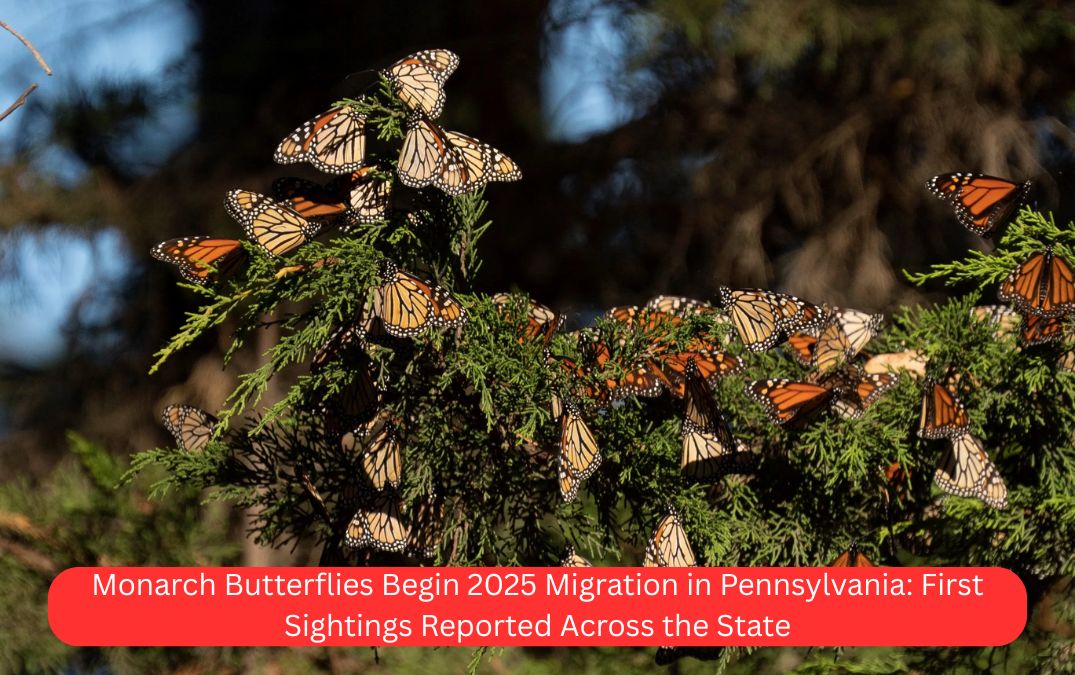Monarch butterflies have officially returned to Pennsylvania as part of their annual spring migration. Sightings in several counties over the past two weeks signal the northbound movement of these iconic pollinators, offering early signs of a hopeful season.
Reports from Journey North’s 2025 tracking map confirm the first monarchs arrived in late April, with continued activity into mid-May.
What Happened
The annual monarch butterfly migration has reached Pennsylvania.
According to Journey North, the first 11 monarchs were spotted across the state, starting with an early arrival in Philadelphia on April 30, 2025.
Key Details
Here are the confirmed monarch butterfly sightings in Pennsylvania so far:
| Location | County | Date |
|---|---|---|
| Philadelphia | Philadelphia County | April 30, 2025 |
| Pittsburgh | Allegheny County | May 5, 2025 |
| McKees Rocks | Allegheny County | May 10, 2025 |
| Pennsylvania Furnace | Centre County | May 10, 2025 |
| Gettysburg | Adams County | May 11, 2025 |
| York | York County | May 12, 2025 |
These sightings were compiled from Journey North’s Monarch (Adult) First Sighting map, captured on May 14, 2025.
Reactions or Statements
Conservationists are cautiously optimistic.
The World Wildlife Fund (WWF) reported in March that the eastern monarch population had nearly doubled during the winter of 2024–2025 in their Mexican overwintering grounds.
This is an encouraging sign but still far below historical averages.
Population Trends and Challenges
While this year’s count showed a rise to 4.42 acres of occupied forest in Mexico (up from 2.22 acres the previous year), it remains among the five lowest totals in the past 32 years.
WWF’s long-term data reveals that monarch populations were strong in the 1990s and early 2000s. However, numbers have dramatically declined, reaching a historic low of just 1.66 acres in 2013–2014.
Continued habitat loss, climate changes, and pesticide use are among the threats facing monarchs both in the U.S. and Mexico.
What’s Next
Residents are encouraged to support monarchs by planting native milkweed and nectar-rich flowers.
You can also track the migration in real time using Journey North’s interactive 2025 Monarch Map — simply press the Play button on the map to watch the butterflies’ progress northward.
FAQs
Q: When do monarchs typically arrive in Pennsylvania?
A: Monarchs usually reach Pennsylvania from late April through early May, depending on weather conditions.
Q: Why is milkweed important for monarchs?
A: Milkweed is the only plant where monarch butterflies lay their eggs and is essential for caterpillar development.
Q: Are monarch populations increasing in 2025?
A: Yes, early data shows the population nearly doubled this past winter, but numbers are still critically low.
Q: How can I help monarch conservation?
A: Plant native milkweed, avoid pesticides, and participate in citizen science programs like Journey North.
Q: Where can I track monarch sightings?
A: Visit Journey North’s 2025 Monarch Map for up-to-date migration tracking
Final Takeaway
The first monarchs of 2025 have touched down in Pennsylvania, sparking hope for a stronger migration season. While the population shows signs of recovery, long-term conservation efforts remain crucial to ensuring their survival.












